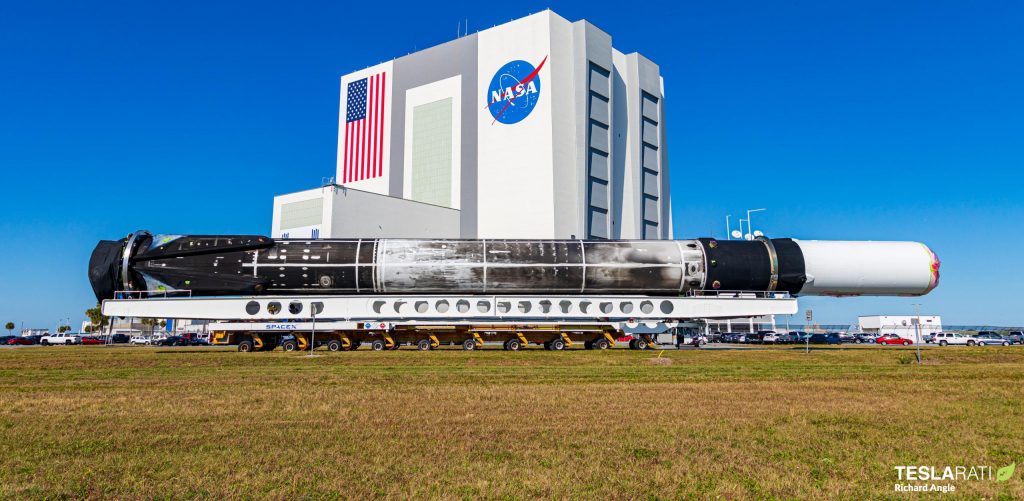

News
SpaceX converts Falcon Heavy booster into Falcon 9
More than two years after the rocket’s last launch, SpaceX appears to have finally decided to give at least one of two surviving Falcon Heavy Block 5 cores a new lease on life as a Falcon 9 booster.
Known as B1052, the Falcon Heavy side core or booster debuted in April 2019 as part of the first flight of the rocket’s Block 5 variant, successfully launching Saudi Arabia’s large Arabsat 6A communications satellite to an almost 90,000 km (56,000 mi) transfer orbit. Following in the footsteps of the first Falcon Heavy, the first Block 5 vehicle repeated its predecessor’s iconic double-landing back at Cape Canaveral. Just 74 days later, both Falcon Heavy Block 5 side boosters B1052 and B1053 launched again, this time supporting the US military’s long-delayed STP-2 rideshare and qualification mission.

Once again, B1052 and B1053 stuck near-simultaneous landings at SpaceX’s Landing Zones. Both missions’ center cores, however, weren’t so lucky. During Arabsat 6A, the first Falcon Heavy Block 5 center core did successfully land but high seas eventually toppled the booster, destroying it and leaving few intact remains. During STP-2, CEO Elon Musk revealed that SpaceX didn’t actually expect to recover the mission’s replacement center core due to the exceptionally hot reentry it would need to survive. As predicted, the center core did not survive, with Musk later reporting that the hot reentry damaged thrust vectoring hardware, causing the rocket to veer off course.



Thankfully, both side boosters aced all four of their collective landings. However, despite previous statements from Musk indicating that Falcon’s new Block 5 design made it fairly easy to convert Falcon first stages between Falcon 9 and Falcon Heavy side booster configurations, both B1052 and B1053 dropped off the face of the Earth immediately after completing STP-2. Only in September 2021, 27 months later, did one of the two cores finally reappear in public – sans landing legs and grid fins but with a nosecone still installed.
As is now clear, that surprise appearance after years in storage was no coincidence. A bit less than three months later after the mystery Falcon Heavy side booster was spotted rolling down a Kennedy Space Center highway from a Cape Canaveral storage hangar to a new SpaceX facility, one of the two side boosters (B1052) was spotted once again – this time with landing legs and a Falcon 9 interstage installed where a nosecone once sat.

Aside from having clearly been converted into a Falcon 9 booster, former Falcon Heavy side booster B1052 was also mated to a new expendable upper stage – a strong indication of an imminent launch. Word on the ground is that the rocket and transporter were on their way to SpaceX’s Cape Canaveral Space Force Station (CCSFS) LC-40 pad for the company’s planned December 18th launch of Turkey’s Turksat 5B communications satellite.
Following SpaceX’s successful NASA IXPE launch on December 9th, the company has two more East Coast launches planned before the end of the year: Turksat 5B NET December 18th and CRS-24 NET December 21st. Several other Falcon 9 boosters (save for B1062, which is probably assigned to CRS-24) are likely available to launch Turksat 5B, so B1052’s assignment – while not implausible – isn’t guaranteed.
Above all else, B1052’s second life as a Falcon 9 is exciting because it means that B1053 probably isn’t far behind it, meaning that SpaceX’s fleet of operational Falcon boosters is about to grow significantly in a short period of time. As of now, that fleet contains eight Falcon 9 boosters that have each completed an average of more than six orbital-class launches. Half have flown nine times. Aside from expanding that fleet by 25%, the reintroduction of B1052 and B1053 will free up SpaceX to retire older boosters like B1049 and B1051, which CEO Elon Musk has said are slower and more expensive to reuse.

News
Tesla (TSLA) receives “Buy” rating and $551 PT from Canaccord Genuity
He also maintained a “Buy” rating for TSLA stock over the company’s improving long-term outlook, which is driven by autonomy and robotics.

Canaccord Genuity analyst George Gianarikas raised his Tesla (NASDAQ:TSLA) price target from $482 to $551. He also maintained a “Buy” rating for TSLA stock over the company’s improving long-term outlook, which is driven by autonomy and robotics.
The analyst’s updated note
Gianarikas lowered his 4Q25 delivery estimates but pointed to several positive factors in the Tesla story. He noted that EV adoption in emerging markets is gaining pace, and progress in FSD and the Robotaxi rollout in 2026 represent major upside drivers. Further progress in the Optimus program next year could also add more momentum for the electric vehicle maker.
“Overall, yes, 4Q25 delivery expectations are being revised lower. However, the reset in the US EV market is laying the groundwork for a more durable and attractive long-term demand environment.
“At the same time, EV penetration in emerging markets is accelerating, reinforcing Tesla’s potential multi‑year growth runway beyond the US. Global progress in FSD and the anticipated rollout of a larger robotaxi fleet in 2026 are increasingly important components of the Tesla equity story and could provide sentiment tailwinds,” the analyst wrote.
Tesla’s busy 2026
The upcoming year would be a busy one for Tesla, considering the company’s plans and targets. The autonomous two-seat Cybercab has been confirmed to start production sometime in Q2 2026, as per Elon Musk during the 2025 Annual Shareholder Meeting.
Apart from this, Tesla is also expected to unveil the next-generation Roadster on April 1, 2026. Tesla is also expected to start high-volume production of the Tesla Semi in Nevada next year.
Apart from vehicle launches, Tesla has expressed its intentions to significantly ramp the rollout of FSD to several regions worldwide, such as Europe. Plans are also underway to launch more Robotaxi networks in several more key areas across the United States.
News
Waymo sues Santa Monica over order to halt overnight charging sessions
In its complaint, Waymo argued that its self-driving cars’ operations do not constitute a public nuisance, and compliance with the city’s order would cause the company irreparable harm.

Waymo has filed a lawsuit against the City of Santa Monica in Los Angeles County Superior Court, seeking to block an order that requires the company to cease overnight charging at two facilities.
In its complaint, Waymo argued that its self-driving cars’ operations do not constitute a public nuisance, and compliance with the city’s order would cause the company irreparable harm.
Nuisance claims
As noted in a report from the Los Angeles Times, Waymo’s two charging sites at Euclid Street and Broadway have operated for about a year, supporting the company’s growing fleet with round-the-clock activity. Unfortunately, this has also resulted in residents in the area reportedly being unable to sleep due to incessant beeping from self-driving taxis that are moving in and out of the charging stations around the clock.
Frustrated residents have protested against the Waymos by blocking the vehicles’ paths, placing cones, and “stacking” cars to create backups. This has also resulted in multiple calls to the police.
Last month, the city issued an order to Waymo and its charging partner, Voltera, to cease overnight operations at the charging locations, stating that the self-driving vehicles’ activities at night were a public nuisance. A December 15 meeting yielded no agreement on mitigations like software rerouting. Waymo proposed changes, but the city reportedly insisted that nothing would satisfy the irate residents.
“We are disappointed that the City has chosen an adversarial path over a collaborative one. The City’s position has been to insist that no actions taken or proposed by Waymo would satisfy the complaining neighbors and therefore must be deemed insufficient,” a Waymo spokesperson stated.
Waymo pushes back
In its legal complaint, Waymo stated that its “activities at the Broadway Facilities do not constitute a public nuisance.” The company also noted that it “faces imminent and irreparable harm to its operations, employees, and customers” from the city’s order. The suit also stated that the city was fully aware that the Voltera charging sites would be operating around the clock to support Waymo’s self-driving taxis.
The company highlighted over one million trips in Santa Monica since launch, with more than 50,000 rides starting or ending there in November alone. Waymo also criticized the city for adopting a contentious strategy against businesses.
“The City of Santa Monica’s recent actions are inconsistent with its stated goal of attracting investment. At a time when the City faces a serious fiscal crisis, officials are choosing to obstruct properly permitted investment rather than fostering a ‘ready for business’ environment,” Waymo stated.
News
Tesla FSD v14.2.2 is getting rave reviews from drivers
So far, early testers have reported buttery-smooth drives with confident performance, even at night or on twisty roads.

Tesla Full Self-Driving (Supervised) v14.2.2 is receiving positive reviews from owners, with several drivers praising the build’s lack of hesitation during lane changes and its smoother decision-making, among others.
The update, which started rolling out on Monday, also adds features like dynamic arrival pin adjustment. So far, early testers have reported buttery-smooth drives with confident performance, even at night or on twisty roads.
Owners highlight major improvements
Longtime Tesla owner and FSD user @BLKMDL3 shared a detailed 10-hour impression of FSD v14.2.2, noting that the system exhibited “zero lane change hesitation” and “extremely refined” lane choices. He praised Mad Max mode’s performance, stellar parking in locations including ticket dispensers, and impressive canyon runs even in dark conditions.
Fellow FSD user Dan Burkland reported an hour of FSD v14.2.2’s nighttime driving with “zero hesitations” and “buttery smooth” confidence reminiscent of Robotaxi rides in areas such as Austin, Texas. Veteran FSD user Whole Mars Catalog also demonstrated voice navigation via Grok, while Tesla owner Devin Olsen completed a nearly two-hour drive with FSD v14.2.2 in heavy traffic and rain with strong performance.
Closer to unsupervised
FSD has been receiving rave reviews, even from Tesla’s competitors. Xpeng CEO He Xiaopeng, for one, offered fresh praise for FSD v14.2 after visiting Silicon Valley. Following extended test drives of Tesla vehicles running the latest FSD software, He stated that the system has made major strides, reinforcing his view that Tesla’s approach to autonomy is indeed the proper path towards autonomy.
According to He, Tesla’s FSD has evolved from a smooth Level 2 advanced driver assistance system into what he described as a “near-Level 4” experience in terms of capabilities. While acknowledging that areas of improvement are still present, the Xpeng CEO stated that FSD’s current iteration significantly surpasses last year’s capabilities. He also reiterated his belief that Tesla’s strategy of using the same autonomous software and hardware architecture across private vehicles and robotaxis is the right long-term approach, as it would allow users to bypass intermediate autonomy stages and move closer to Level 4 functionality.








